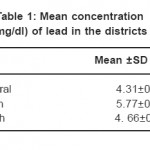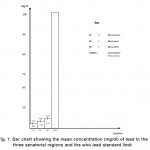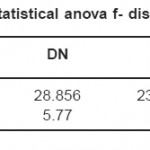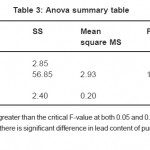Determination of the Lead Content of Pumpkin Leaf Telfairia occidentalis in Selected Towns of Delta State Covering the three (3) Senatorial Districts of the State
A.O. Opajobi1 * , C.O. Esume2 , A. Osasuyi3 and C.C. Okehie2
DOI: http://dx.doi.org/10.12944/CWE.6.1.04
Consumption of foods and vegetables contaminated with heavy metals is a major cause of disease and debility. In this study carried out in 15 non-oil prospecting selected towns in Delta State, Nigeria covering the three (3) senatorial districts of the state, and five (5) towns from each of the senatorial districts, the lead content of Telfairia occidentalis was determined.The mean lead concentration of the locations were tabulated with P< 0.05 student t-test and F-distribution ANOVA at P< 0.05 and P< 0.01 and these showed a significant difference among the three (3) senatorial districts. The mean concentration of lead in each district are 4.660mg/kg for Delta South, 5.771mg/kg for Delta North and 4.305mg/kg for Delta central with none exceeding the approved standard limit of 100mg/kg of the World Health Organisation. It can therefore be hypothesized that Telfairia occidentalis cropped within Delta State, Nigeria, in non-oil prospecting locations is safe for human consumption with regard to lead levels.
Copy the following to cite this article:
Opajobe A.O, Esume C.O, Osasuyi A, Okehie C.C. Determination of the Lead Content of Pumpkin Leaf Telfairia occidentalis in Selected Towns of Delta State Covering the three (3) Senatorial Districts of the State. Curr World Environ 2011:6(1);39-44 DOI:http://dx.doi.org/10.12944/CWE.6.1.04
Copy the following to cite this URL:
Opajobe A.O, Esume C.O, Osasuyi A, Okehie C.C. Determination of the Lead Content of Pumpkin Leaf Telfairia occidentalis in Selected Towns of Delta State Covering the three (3) Senatorial Districts of the State. Curr World Environ 2011:6(1);39-44. Available from: http://www.cwejournal.org?p=306/
Download article (pdf) Citation Manager Publish History
Select type of program for download
| Endnote EndNote format (Mac & Win) | |
| Reference Manager Ris format (Win only) | |
| Procite Ris format (Win only) | |
| Medlars Format | |
| RefWorks Format RefWorks format (Mac & Win) | |
| BibTex Format BibTex format (Mac & Win) |
Article Publishing History
| Received: | 2011-03-25 |
|---|---|
| Accepted: | 2011-05-02 |
Introduction
Telfairia Occidentalis is an important staple vegetable grown in Nigeria being known for both its nutritional and medicinal values. It is commonly called fluted pumpkin of the cucurbitaceae family and is known by several common names in Nigeria, namely Ugu (Igbo), iroko or Aporoko (Yoruba), Ubong (Efik), Umee (Urhobo), Umeke (Edo). (Akoroda, 1990) It occurs in the forest zone of West africa, most frequently in Benin, Nigeria and Cameroon. It is a popular vegetable all over Nigeria. It is rare in Uganda and absent in the rest of East Africa. It has been suggested that it originated in South East Nigeria and was distributed by the Igbos. It is equally possible that fluted pumpkin was originally wild throughout its current range, but that wild plant has been harvested to local extinction and is now replaced by cultivated forms (Badifu and Ogunsina, 1991) Telfairia occidentalis leaf is rich in minerals (Iron, Potassium, Sodium, Phosphorus, Calcium and Magnesium), antioxidants, vitamins (thiamine, riboflavin, nicotinamide and ascorbic acids) and phyto-chemicals such as phenols. The amino acid profile of T. occidentalis has also been shown to be very rich and includes alanine, aspartate, glycine, glutamine, histamine, lysine, methionine, tryptophan, cysteine, leucine, arginine, serine, threonine, phenylalanine, valine, tyrosine and isoleucine. (Tindall, 1968; Fasuyi; 2006)
Plants provide an alternative strategy for new drugs. It is likely that plants and vegetables will continue to be a valuable source of new molecules which may after possible chemical manipulation, provide new and improved drugs vegetables. (Sharma et al. 2006).The contamination of vegetables with heavy metals due to soil and atmospheric contamination poses a threat to its quality and safety and has been a serious concern to food safety in many cities including some towns in Delta State. Many anthropogenic sources such as waste incineration, industrial processes and motor vehicles, use of pesticides, emit heavy metals into the atmosphere. According to Hart et al. 2005, there is a high lead content level in oil prospecting locations in Rivers state, Nigeria, though, below the acceptable standard limit of the World health organization. Dietary intake of heavy metals poses a high risk to animals and human health. High concentrations of heavy metals such as lead(Pb), cadmium(Cd), copper(Cu) in fruits and vegetables were related to high prevalence of upper gastrointestinal cancer (Turkdogan et. al, 2003). Regulations have been set up in many countries and for different industrial areas to control the emission of heavy metals to prevent its contamination of the food chain. Food chain contamination is one of the important pathways for the entry of these toxic pollutants into the human body (Ferner, 2001; Ma et al, 2006). Lead contamination of air and soils on which these vegetables are planted is a factor which needs to be put into consideration (Ikeda et. al, 2000) Excessive accumulation of heavy metals in agricultural lands through many sources results in soil contamination and elevated heavy metal uptake by crops and vegetables and this affects food quality and safety (Ho and Tai, 1988; Garcia and Millan 1998).
However, in a similar study carried out in two (2) major highways in Lagos by Atayese et. al.2008 in Nigeria to determine the extent of some heavy metal (Cd, Pb) contamination in vegetable tissue using Amaranthus viridis and soil samples findings indicate that while the levels of metals in soil were within the critical limits proposed by Kabata- Pendias and Pendias (1984), the range within the plant leaves were above the normal limit for plants.
Lead and its compounds found in the atmosphere are some of the substances that pollute the atmosphere, the toxicity is due to the fact that Pb and other heavy metals are powerful inhibitors of enzymes reactant. Due to its toxicity, its varied usefulness had to be reviewed to eliminate or eradicate its side effects. Lead compounds from exhausts of automobiles using leaded gasoline accumulates especially in cities and along heavily traveled streets. Industrial uses of lead and of products containing lead have greatly increased the amount of lead in the environment (Stellman et. al 1998). Usually Pb is released into the atmosphere in a gaseous form or dust form, thus spread in the atmosphere comes in contact with food, water, person, animals, plants as we will see in the case of pumpkin leaves, and other components of the ecosystem. This implies that humans, animals and plants in areas where lead is released much into the atmosphere absorb more lead than those in areas where lead is released in small quantities (Rodriguez-Flores et. al. 1982).
The maximum allowable concentration of lead in air is 0.5 mg/m3. So if this limit is exceeded, the lives of some living organisms are threatened. (Pilegard and Johnson , 1984). The uptake and bioaccumulation of heavy metals in vegetables are influenced by many factors such as climate, atmospheric depositions, concentration of lead in the soil, the nature of soil and the degree of maturity of the plants at harvest (Scott et al., 1994: Voutsa et al., 1996).
Air pollution many pose a threat to post-harvest vegetable during transportation and marking, causing elevated levels of the heavy metals, Pb inclusive, in vegetables like T. Occidentalis (Sharma et al., 2008). Elevated levels of lead in vegetables are reported in long term uses of treated or untreated waste water (Sharma et al., 2006, 2007; Adeniyi, 1996, Sinha et al., 2005).
Other anthropogenic sources of lead and other heavy metals include the addition of manures, sewage sludge, fertilizers and pesticides which may modify the physiochemical properties of the soil such as pH, organic matter and bioavailability of Lead in soil (Yusuf and Osibanjo, 2006). Whatmuff (2002) and McBride (2003) found that increasing concentration of heavy metal such as lead in soil also increase the uptake.
Green leafy vegetables may absorb lead from soil where exposure is high, such as near freeways or main roads and near lead smutting plants, contaminated dirt from the garden and other areas where human activities can introduce lead into the environment. When vegetables are not well washed before consumption lead may gain access to the body, so if a home garden is desired and the property is in or near an area of high exposure, soil should be tested before planting (Sharma et al, 2006). It is most common for lead to slowly build up over time from repeated exposure to small amounts of it. Lead is much more harmful in children than adult, because it can severely affect the developing brain and nerves of children.
Material and Methods
Study Areas
This study was carried out between December and January, 2011, in some selected towns in Delta State, located in the Niger- Delta region of Nigeria, covering the three senatorial districts.These towns include:
Delta North - Obiaruku, Agbor, Asaba, Abbi and Umunede.
Delta central - Abraka, Eku, Sapele, Warri and Ughelli.
Delta South – Oleh, Ozoro, Oyede , Irri , Iyede.
Sampling Procedure
Three bunch samples of Telfairia occidentalis l were collected at random locations of the five (5) different towns in each of the three(3) senatorial districts of the state.
Sample Preparation
The freshly collected samples were identified in the taxonomy department of the Delta State University, Abraka and weighed after washing in de-ionised water, drained in a colander.The samples were then sun-dried for two (2) weeks before they were finally dried in an oven at 600c for 1 hour using Aluminium plate and cooled to ambient temperature. The dried samples were grinded with the aid of mortar and pestle, after which, they were sieved through a mesh of 3mm diameter and stored in airtight plastic containers until required for analysis.
 |
Table 1: Mean concentration (mg/dl) of lead in the districts Click here to View table |
 |
Figure 1: Bar chart showing the mean concentration (mg/dl) of lead in the three senatorial regions and the who lead standard limit. Click here to View figure |
 |
Table 2: Statistical anova f- distribution Click here to View table |
 |
Table 3: Anova summary table Click here to View table |
Method of Digestion
2g of the samples were weighed in 100ml conical flask, and 25ml of digestion solution or aqua-regia mixture (70% high purity HN03 and HCl ratio 3:1) and 5mls 30% H202 were added as described by Rodrigues- flores and Rodriguez –castellon, 1982. The mixture was heated at 800c for 3 hours (Ashing). Thereafter the ash was dissolved using 20ml of de-ionized water. The mixture was filtered using Whatman N0. 42 filter paper 9cm to complete the digestion of organic matter. The solution was stored in a clean bottle for analysis.
Instrument Procedure
The mixture was transferred to a 50ml volumetric flash, filled to the mark, and let to settle for at least 2 hours. The supernatant was analyzed for total Lead (Pb) content by Atomic Absorption spectrophotometer (Model Buck 210 GVP).
Conclusion
Plants have developed during their evolution several biochemical mechanisms that have resulted in adaptation to and tolerance of, new or chemically imbalanced growth media. Therefore, plant responses to trace elements in the soil and ambient air can vary and should always be investigated for the particular soil–plant system. A. Kabata-Pendias (1984) This indicates that Vegetables have appreciable role in sustainable development through food and nutritional security (Sharma, 2005) and so an invigorating value of vegetables cannot be under estimated.
On the basis of the results obtained in this study it can be postulated that the pumpkin leaf cropped and used Delta State are not contaminated with lead and so are safe for human consumption as the lead levels are far below the tolerated standard limit by WHO. Though free from lead contamination, soil testing before planting is still encouraged. Allocation of land for industrial use and prohibition of farming around susceptible areas within the state could help reduce the use of hazardous areas of agricultural activities.
References
- Adeniyi, A A., Determination of cadmium, copper, iron, lead, manganese and zinc in water leaf (Talinum triangulare) in dumpsites. Environ. Int., 22: 259-262 (1996).
- Akoroda, M.O., Ethnobotany of Telfairia occidentalis (cucurbitaceae) among lgbos ofNigeria. Econ. Bot., 44: 29-39 (1990).
- Atayese, M. O., Eigbadon, A.I., Oluwa , K. A. and Adesodun ,J.K., Heavy metal contamination of Amaranthus grown along major highways in Lagos, Nigeria. African Crop Science Journal. 16(4): 225-235 (2008).
- Badifu, G. I.O and Ogunsina,A.O, Chemical composition of kernels from some Species of cucurbitaceous growth in Nigeria. Plant Food Human Nutr.,41: 35-44 (1991).
- Fasuyi,A. O, Nutritional potentials of some tropical vegetable leaf meals: chemical characterization and functional properties. Afr. J. Biotechnol., 5: 49-53 (2006).
- Ferner, D. J., F. M F. M Toxicity heavy metals. eMed. Jor. 2 (5): 1 (2001).
- Garcia, R. and Millan, E., Assessment of Cd, Pb and Zn contamination in roadside soils and grasses from Gipuzkoa (Spain). Chemosphere 37: 1615-1625 (1998).
- Georges, Audi. “The Ubase Evaluation of Nuclear and Decay properties”. Nuclear physical (atomic Mass Data center) J. Nuclphysa. 729: 3-128 (2003).
- Heskel, D. L, A model for the Adoption of metallurgy in the Ancient Middle East. Current anthropology 24(3): 362-366 (1983).
- Ho, I. B. and Tai, K. M., Elevated levels of lead and other Metals in Roadside Soil and Grass and their use to monitor Aerial metal Depositions in Hong Kong. Environ. Pollut. 49: 37-51 (1988).
- Ikeda, M., Zhang, Z.W., Shimbo, S., Watanabe, T., Nakatsuka, H., Moon, C.S., Matsuda-Kabata-Pendias, A. and Pendias, H., Trace elements in Soils and Plants. CRC Press, Boca Raton, USA (1984).
- Ma, H. W., Hung, M. L., Chen, P. C., A systemic health risk assessment for the chromium cycle in Taiwan. Environment International. 10: 1016 (2006).
- McBride, M. B.,Toxic metals in sewage sludge- amended soils: has proportion of beneficial use discounted the risks? Adv. Environ. Res., 8: 5-19 (2003).
- Pilegaard K and Johnsen .(1984)Heavy Metal Uptake from Air and Soil by Transplanted Plants of Achilea millefolium and Hordeum vulgare.. L Ramussen Ed.Ecological Bulletin (NFR) (Ecotoxicology: 3rd Oikos Conference), 36: 97-102 (1984).
- Rodrigues- Flores, M. and Rodriges-Castellon, E., Lead and cadmium levels in soil and plants near highways and their correlation with traffic density environ. Poll. Ser. B, 4: 281-281 (1982).
- Sharma, J.P, Vegetable breeding ,a perspective .Sharma, R.,K., M. Agrawal and F. M. Marshall, Heavy metals contamination in vegetables grown in water irrigated areas of varanasi, India Bull. Environ. Contaminate. Toxicol., 77: 312-318 (2006).
- Sharma, R. K., M. Agrawal and. Marshall., Heavy meals contamination of soil and vegetables in suburban areas of Varanasi, India Ecotoxicol. Environ. Safe., 66: 258-266 (2007).
- Sharma, R.K., M. Agrawal and Marshall, F. M, Heavy metal (Cu, Zn Cd and Pb) contamination of vegetables in urban India: abase study in varanasi. Environ. Pollut., 154: 254-263 (2008).
- Stellman, Jeanne Mager, Encyclopaedia of Occupational health and safety. International labour organization. 81.2-81.4 (1998).
- Sinha, S. K, Pandey, A. K., Grupta and K. Bhatt, K., Accumlation of metals in vegetables and crops grown in theara irrigated with river water Bull. Environ. Contaminate. Toxicol., 74: 210-218 (2005).
- Tindall, H. D., Commercial vegetable Growing. 1st Edn., Oxford university press, Oxford Uk (1968).
- Tyler, V. E., Phytomedicines: Back to the future J. Nat. prod., 62: 1589-1592 (1999).
- Turkdogan, M. K, F., Kilicel, K. Kara and I. Tuncer., Heavy metals in soil, vegetables and fruits in the endemic upper gastrointestinal cancer region of Turkey Environ. Toxicol. Pharmacol., 13: 175-179 (2003).
- Voutsa, D. A., Grimanis and Samara, C., Trace elements in vegetables grown in industrial areas in relation to soil and air particulate matter environ. Pollut. 94: 325-335 (1996).
- Whatmuff, M., S., Applying bio-solids to acid soil in New South Wales: are guideline soil metal limits from other countries appropriate? Aust. J. Soil Res., 40: 10411056 (2002).
- Windholz, Martha., Merck Inded of chemicals and Drugs, 9th ed., monography 8393 (1976).
- Yusuf, K. A and Osibanjo,O,race metals in water and sediments from Ologe lagoon, Southwester Nigeria Pak. J. Sci. Ind. Res., 49: 88-96 (2006).







